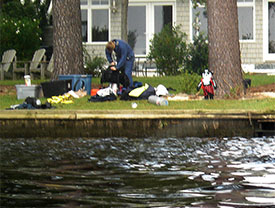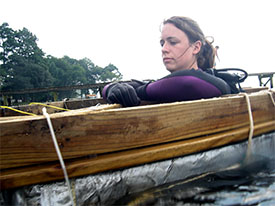ECU's 2006 Fall Field School
Project Journal
18 September 2006
By Amy Leuchtmann

Well, once again I have the pleasure of writing on Monday. However, in a shocking turn of events, I can report with pleasure that EVERYTHING worked as planned! Did I mention that this is a shocking turn of events?

Roger keeps a weather eye on Site B.
The morning began with a Site Strategy Plan presented by Trish and Adam. The rest of the team will be following their lead on Site B. There is only one boat here, which we have named the Padgett Vessel. The names come from the fact that it is directly off the waterfront property of the Padgett family. Okay, perhaps it’s not the most creative way to name something, but it is a relatively common procedure. This vessel will need to be dredged (you can imagine the groans heard in the briefing room at this news). Luckily, this vessel is resting on a sandier substrate than at Site A which was all mud. While we’re hoping that the sand proves easier to suck up with the dredge, we’re fairly certain that visibility under the water will be clearer anyway.

Yes, more dredging. It's Amy's turn to sift through dredge spoil.
Once the sand has been moved off the wreck, we will be using a new (to us) technique to record the crucial measurements of the ship. By record, what I mean is that we will measure every piece of timber, take note of where fasteners (nails, pins, and spikes) are, and try to discern any repairs that may have been made during its working lifetime. Then we make a detailed drawing of the wreck site that can be published with the written report of our findings. So far, we students have been trained to do this using measuring tapes, Mylar (a special paper that you can write on underwater), clipboards, and pencils. However, this project we will be using a more technologically advanced method using a computer. Oh, we will still have measuring tapes, Mylar, clipboards, and pencils, but now we’re going to make it “easier” on ourselves by letting a little screen and a lot of algorithms tell us if we’re doing things right or wrong.
Now, I am sure that those of you who have been following along with these daily entries are now asking yourselves, “What?! It takes them days to figure out how to make a simple dredge work, now they’re involving computers? What are they thinking?!” Frankly…I don’t have an answer to that!
Speaking of making things work. We figured out our problem with the dredge today. When I am holding the dredge head and we turn it on, it works. When anyone else holds it and we try to turn it on, it doesn’t work. That simple! Well, it may have also helped that Adam was not allowed anywhere near the hoses or engine.
To use Site Recorder, the computer program that will allow us to feed the measurements in and let it construct the drawing for us, we need to set up datum points around the wreck. Datum points are simply fence posts that we stick into the sand around the perimeter of the site. Their positions will never change and all of our measurements will be based off these datum points. Today we put eight of these datum points around the wreck, making them extra secure. While half of the team worked on the fence posts, another pair began dredging at the bow. And for the record, that dredge ran perfectly for close to three hours, without a single hitch!
For more information you can visit the ECU website at:
http://www.ecu.edu/maritime/index.htm
Return to Project Journal home page.

